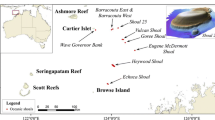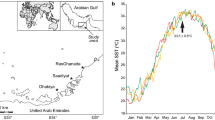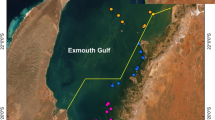Abstract
Abiotic determinants of community composition on shallow reefs are seldom examined at a scale transcending biogeographic regions, and knowledge for the western Indian Ocean is sparse. To address this deficit, turnover in reef community composition was quantified, using gradient forest analyses, along gradients of nine abiotic variables collected in situ or via remote sensing at 54 sites across and within three bioregions: Tropical Western Indian Ocean (Tropical WIO), Delagoa and Natal, spanning 4800 km of east African coastline (5.2–31.1°S). All oceanographic variables differed significantly among bioregions. At a scale across bioregions, wave height declined northwards, while temperature increased. Values for suspended inorganic sediments, chlorophyll-a concentration [chl-a], turbidity and nutrients were all lowest in Delagoa, in association with the scarcity of rivers there. The most novel and unexpected finding was that the northwards decline in wave action was more strongly associated with changes in community composition across bioregions than any other variable. Temperature was the second-most important variable at that scale. Within bioregions, temperature and [chl-a] had strongest relationships with community composition in the Tropical WIO. By contrast, in Delagoa, reef profile, susceptibility to sand inundation and reef heterogeneity were most strongly associated with community composition; and in Natal, depth, turbidity and suspended sediment were foremost. Variables of greatest importance within bioregions distilled to (1) those influencing food/energy supply ([chl-a], turbidity, depth and suspended sediments), which were of particular importance in the Tropical WIO and Natal bioregions, and (2) those altering sand inundation and small-scale current dynamics of reefs (profile, heterogeneity and depth), which were leading factors in the Delagoa Bioregion.






Similar content being viewed by others
References
Abelson A, Miloh T, Loya Y (1993) Flow patterns induced by substrata and body morphologies of benthic organisms, and their roles in determining availability of food particles. Limnol Oceanogr 38:1116–1124
Anderson RJ, McKune C, Bolton JJ, DeClerk O, Tronchin E (2005) Patterns in subtidal seaweed communities on coral-dominated reefs at Sodwana Bay on the KwaZulu-Natal coast, South Africa. Afr J Mar Sci 27:529–537
Anderson MJ, Gorley RN, Clarke KR (2008) PERMANOVA + for PRIMER: Guide to software and statistical methods. PRIMER-E, Plymouth
Anthony KRN, Fabricius KE (2000) Shifting roles of heterotrophy and autotrophy in coral energetics under varying turbidity. J Exp Mar Biol Ecol 252:221–253
Anthony KRN, Connolly SR, Hoegh-Guldberg O (2007) Bleaching, energetics, and coral mortality risk: effects of temperature, light, and sediment regime. Limnol Oceanogr 52:716–726
Baith K, Lindsay R, Fu G, McClain CR (2001) SeaDAS: a data analysis system for ocean color satellite sensors. EOS Trans AGU 82:202
Barlow R, Lamont T, Kyewalyanga M, Sessions H, van den Berg M, Duncan F (2011) Phytoplankton production and adaptation in the vicinity of Pemba and Zanzibar islands, Tanzania. Afr J Mar Sci 33:283–295
Becking LE, Cleary DF, de Voogd NJ, Renema W, de Beer M, van Soest RW, Hoeksema BW (2006) Beta diversity of tropical marine benthic assemblages in the Spermonde Archipelago, Indonesia. Mar Ecol 27:76–88
Benton MJ (2009) The red queen and the court jester: species diversity and the role of biotic and abiotic factors through time. Science 323:728–732
Berry PF (1982) Biomass and density of detritivores on a littoral rocky reef on the Natal Coast, with an estimate of population production from the ascidian Pyura stolonifera. ORI Special publication No. 53. p 12
Blamey LK, Branch GM (2009) Habitat diversity relative to wave action on rocky shores: implications for the selection of marine protected areas. Aquat Conserv 19:645–657
Blanchette CA, Miner CM, Raimondi PT, Lohse D, Heady KE, Broitman BR (2008) Biogeographical patterns of rocky intertidal communities along the Pacific coast of North America. J Biogeogr 35:1593–1607
Bolton J, Anderson R (1990) Correlation between intertidal seaweed community composition and sea water temperature patterns on a geographic scale. Bot Mar 33:447–457
BRAT ver. 1.1.1 (2008) Basic radar altimetry toolbox, version 1.1.1. European Space Agency and the Centre National d’Etudes Spatiales
Breiman L (2001) Random forests. Mach Learn 45:5–32
Bustamante RH, Branch GM (1996) Large scale patterns and trophic structure of southern African rocky shores: the roles of geographic variation and wave exposure. J Biogeogr 23:339–351
Bustamante RH, Branch GM, Eekhout S, Robertson B, Zoutendyk P, Schleyer M, Dye A, Hanekom N, Keats D, Jurd M, McQuaid C (1995) Gradients of intertidal primary productivity around the coast of South Africa and their relationships with consumer biomass. Oecologia 102:189–201
Carter R, d’Aubrey J (1989) Inorganic nutrients in Natal continental shelf waters. In: Schumann EH (ed) Lecture notes on coastal and estuarine studies. Springer, Boston, pp 131–151
Chase JM, Leibold MA (2003) Ecological niches: linking classical and contemporary approaches. University of Chicago Press, Chicago
Chase JM, Myers JA (2011) Disentangling the importance of ecological niches from stochastic processes across scales. Philos Trans R Soc B 366:2351–2363
Chen G, Chapron B, Ezraty R, Vandemark D (2002) A global view of swell and wind sea climate by satellite altimeter and scatterometer. J Atmos Ocean Tech 19:1849–1859
Chesson P, Kuang JJ (2008) The interaction between predation and competition. Nature 456:235–238
de Lecea AM, Smit AJ, Fennessy ST (2016) Riverine dominance of a nearshore marine demersal food web: evidence from stable isotope and C/N analysis. Afr J Mar Sci 38(Supplement):S181–S192
De’ath G G, Fabricius K (2010) Water quality as a regional driver of coral biodiversity and macroalgae on the Great Barrier Reef. Ecol Appl 20:840–850
Denny MW (1985) Wave forces on intertidal organisms: a case study. Limnol Oceanogr 30:1171–1187
Denny MW (1988) Biology and the mechanics of the wave-swept environment. Princeton University Press, Princeton
Denny MW (1995) Predicting physical disturbance: mechanistic approaches to the study of survivorship on wave-swept shores. Ecol Monogr 65:371–418
Dustan P, Doherty O, Pardede S (2013) Digital reef rugosity estimates coral reef habitat complexity. PLoS ONE 8:e57386
Ellis N, Pitcher CR (2011) Uncertainty for biodiversity prediction. In: Bax NJ (ed) CERF report on transition and extension program. Marine Biodiversity Hub, Hobart, Tasmania, pp 57–60. http://www.nerpmarine.edu.au/document/cerf-report-transition-and-extension-program. Accessed 20 December 2016
Ellis N, Smith SJ, Pitcher CR (2012) Gradient forests: calculating importance gradients on physical predictors. Ecology 93:156–168
Fabricius KE (2005) Effects of terrestrial runoff on the ecology of corals and coral reefs: review and synthesis. Mar Pollut Bull 50:125–146
Fabricius KE, De’ath G, McCook L, Turak E, Williams DM (2005) Changes in algal, coral and fish assemblages along water quality gradients on the inshore Great Barrier Reef. Mar Pollut Bull 51:384–398
Fleitmann D, Dunbar RB, McCulloch M, Mudelsee M, Vuille M, McClanahan TR, Cole JE, Eggins S (2007) East African soil erosion recorded in a 300 year old coral colony from Kenya. Geophys Res Lett 34:L04401
Gammelsrød T (1992) Variation in shrimp abundance on the Sofala Bank, Mozambique, and its relation to the Zambezi River runoff. Estuar Coast Shelf Sci 35:91–103
Guinotte JM, Buddemeier RW, Kleypas JA (2003) Future coral reef habitat marginality: temporal and spatial effect of climate change in the Pacific basin. Coral Reefs 22:551–558
Hamilton H, Brakel W (1984) Structure and coral fauna of East African reefs. Bull Mar Sci 34:248–266
Helmuth B, Denny MW (2003) Predicting wave exposure in the rocky intertidal zone: do bigger waves always lead to larger forces? Limnol Oceanogr 48:1338–1345
Hubbell SP (2001) The unified neutral theory of biodiversity and biogeography. Princeton University Press, Princeton
Hutchinson GE (1959) Homage to Santa Rosalia or why are there so many kinds of animals? Am Nat 93:145–159
Kechang NI, Yining LI, Zehao SH, Fangliang HE, Jingyun F (2009) Community assembly: relative importance of neutral theory and niche theory. Biodivers Sci 17:579–593
Keith SA, Baird AH, Hughes TP, Madin JS, Connolly SR (2013) Faunal breaks and species composition of Indo-Pacific corals: the role of plate tectonics, environment and habitat distribution. Proc R Soc B 280:20130818
Kyewalyanda MS, Naik R, Hegde S, Raman M, Barlow R, Roberts M (2007) Phytoplankton biomass and primary production in Delagoa Bight Mozambique: application of remote sensing. Estuar Coast Shelf Sci 74:429–436
Leal MC, Sá C, Nordez S, Brotas V, Paula J (2009) Distribution and vertical dynamics of plankton communities at Sofala Bank, Mozambique. Estuar Coast Shelf Sci 84:605–616
Lenihan HS (1999) Physical–biological coupling on oyster reefs: how habitat structure influences individual performance. Ecol Monogr 69:251–275
Littler MM, Martz DR, Littler DS (1983) Effects of recurrent sand deposition on rocky intertidal organisms: importance of substrate heterogeneity in a fluctuating environment. Mar Ecol Prog Ser 11:129–139
Lutjeharms JRE (2006) Three decades of research on the greater Agulhas Current. Ocean Sci 3:129–147
McClanahan TR (1988) Seasonality in East Africa’s coastal waters. Mar Ecol Prog Ser 44:191–199
McClanahan TR (2008) Food-web structure and dynamics of East African coral reefs. In: McClanahan TR, Branch GM (eds) Food webs and the dynamics of marine reefs. Oxford University Press, New York, pp 162–184
McQuaid CD, Branch GM (1984) The influence of sea temperature, substratum and wave exposure on rocky intertidal communities: an analysis of faunal and floral biomass. Mar Ecol Prog Ser 19:145–161
McQuaid CD, Branch GM (1985) Trophic structure of rocky intertidal communities: response to wave action and implications for energy flow. Mar Ecol Prog Ser 22:153–161
McQuaid CD, Dower KM (1990) Enhancement of habitat heterogeneity and species richness on rocky shores inundated by sand. Oecologia 84:142–144
McQuaid CD, Lindsay TL (2007) Wave exposure effects on population structure and recruitment in the mussel Perna perna suggest regulation primarily through availability of recruits and food, not space. Mar Biol 151:2123–2131
Meyer AA, Lutjeharms JRE, de Villiers S (2002) The nutrient characteristics of the Natal Bight, South Africa. J Mar Syst 35:11–37
Muscatine L, Porter JW (1977) Reef corals: mutualistic symbioses adapted to nutrient-poor environments. Bioscience 27:454–460
Obura D (2012) The diversity and biogeography of western Indian Ocean reef-building corals. PLoS ONE 7:e45013
Oksanen J, Blanchet FG, Kindt R, Legendre P, Minchin PR, O’Hara RB, Simpson GL, Solymos P, Stevens MH, Wagner HH (2010) Vegan: Community ecology package. R package version 2.2-1
Peres-Neto PR, Jackson DA (2001) How well do multivariate data sets match? The advantages of a Procrustean superimposition approach over the Mantel test. Oecologia 129:169–178
Pitcher CR, Ellis N, Smith SJ (2011) Example analysis of biodiversity survey data with R package gradientForest. http://gradientforest.r-forge.r-project.org/biodiversity-survey.pdf. Accessed 20 Dec 2016
Pitcher CR, Lawton P, Ellis N, Smith SJ, Incze LS, Wei C-L, Greenlaw ME, Wolff NH, Sameoto J, Snelgrove PVR (2012) Exploring the role of environmental variables in shaping patterns of seabed biodiversity composition in regional-scale ecosystems. J Appl Ecol 49:670–679
Polunin NVC, Roberts CM (1993) Greater biomass and value of target coral-reef fishes in two small Caribbean marine reserves. Mar Ecol Prog Ser 100:167–176
Porter SN, Branch GM, Sink KJ (2013) Biogeographic patterns on shallow subtidal reefs in the western Indian Ocean. Mar Biol 160:1271–1283
Porter SN, Kaehler S, Branch GM, Sink KJ (2014) Riverine subsidies for inshore filter-feeder communities: potential influences on trophic patterns among bioregions. Mar Ecol Prog Ser 498:13–26
Porter SN, Branch GM, Sink KJ (2017) Sand-mediated divergence between shallow reef communities on horizontal and vertical substrata in the western Indian Ocean. Afr J Mar Sci (Accepted)
R Development Core Team (2014) R: a language and environment for statistical computing. Version 3:3
Ramm AEL, Cooper JAG, Harrison TD, Singh A (1990) Natal estuarine and coastal research unit. Annual report for 1989–1990. CSIR. p 119
Riaux-Gobin C, Witkowski A, Saenz-Agudelo P, Neveux J, Oriol L, Vétion G (2011) Nutrient status in coral reefs of the Îles Eparses (Scattered Islands): comparison to nearby reefs subject to higher anthropogenic influences (Mozambique Channel and Mascarenes, Indian Ocean). Oceanol Hydrobiol Stud 40:84–90
Riegl B (1995) Effects of sand deposition on scleractinian and alcyonacean corals. Mar Biol 121:517–526
Riegl B (2001) Inhibition of reef framework by frequent disturbance: examples from the Arabian Gulf, South Africa, and the Cayman Islands. Palaeogeogr Palaeocl 175:79–101
Riegl B, Branch GM (1995) Effects of sediment on the energy budgets of four scleractinian (Bourne 1900) and five alcyonacean (Lamouroux 1816) corals. J Exp Mar Biol Ecol 186:259–275
Riegl B, Riegl A (1996) How episodic coral breakage can determine community structure: a South African coral reef example. Mar Ecol 17:399–410
Riegl B, Schleyer MH, Cook PJ, Branch GM (1995) Structure of Africa’s southernmost coral communities. Bull Mar Sci 56:676–691
Roberts MJ, Ternon J-F, Morris T (2014) Interaction of dipole eddies with the western continental slope of the Mozambique Channel. Deep-Sea Res Pt II 100:54–67
Rodrigues MJ, Motta H, Whittington MW, Schleyer M (2000) Coral reefs in Mozambique. Their ecology and conservation. In: McClanahan TR, Sheppard CRC, Obura DO (eds) Coral reefs of the Indian Ocean. Oxford University Press, Oxford, pp 107–129
Rogers C (1990) Responses of coral reefs and reef organisms to sedimentation. Mar Ecol Prog Ser 62:185–202
Scharler UM, Ayers MJ, de Lecea AM, Pretorius M, Fennessy ST, Huggett JA, MacKay CF, Muir D (2016) Riverine influence determines nearshore heterogeneity of nutrient (C, N, P) content and stoichiometry in the KwaZulu-Natal Bight, South Africa. Afr J Mar Sci 38(Supplement):S193–S203
Schleyer MH, Celliers L (2003) Coral dominance at the reef–sediment interface in marginal coral communities at Sodwana Bay, South Africa. Mar Freshw Res 54:967–972
Shears NT (2007) Biogeography, community structure and biological habitat types of subtidal reefs on the South Island west coast, New Zealand. Sci Conserv 281:1–53
Sink KJ (2001) A hierarchical analysis of abiotic determinants and harvesting impacts in the rocky intertidal communities of KwaZulu–Natal. Ph.D. thesis, University of Cape Town, South Africa, p 277
Sink KJ, Branch GM, Harris JM (2005) Biogeographic patterns in rocky intertidal communities in KwaZulu-Natal, South Africa. Afr J Mar Sci 27:81–96
Sommer B, Harrison PL, Beger M, Pandolfi JM (2014) Trait-mediated environmental filtering drives assembly at biogeographic transition zones. Ecology 95:1000–1009
Spalding MD, Fox HE, Allen GR, Davidson N, Ferdaña ZA, Finlayson M, Halpern BS, Jorge MA, Lombana A, Lourie SA, Martin KD, McManus E, Molnar J, Recchia CA, Robertson J (2007) Marine ecoregions of the world: a bioregionalization of coastal and shelf areas. Bioscience 57:573–583
StatSoft (2007) STATISTICA (data analysis software system), version 8. Tulsa
Swart NC, Lutjeharms JRE, Ridderinkhof H, de Ruijter WPM (2010) Observed characteristics of Mozambique eddies. J Geophys Res 115:CO9006
Thomson RJ, Hill NA, Leaper R, Ellis N, Pitcher R, Barrett NS, Edgar GJ (2014) Congruence in demersal fish, macroinvertebrate, and macroalgal community turnover on shallow temperate reefs. Ecol Appl 24:287–299
Underwood AJ, Chapman MG, Connell SD (2000) Observations in ecology: you can’t make progress on processes without understanding the patterns. J Exp Mar Biol Ecol 250:97–115
Wiens JJ (2011) The niche, biogeography and species interactions. Philos Trans R Soc B 366:2336–2350
Wieters EA (2005) Upwelling control of positive interactions over mesoscales: a new link between bottom-up and top-down processes on rocky shores. Mar Ecol Prog Ser 301:43–54
Witman JD, Brandt M, Smith F (2010) Coupling between subtidal prey and consumers along a mesoscale upwelling gradient in the Galápagos Islands. Ecol Monogr 80:153–177
Yasin JA, Kroeze C, Mayorga E (2010) Nutrients export by rivers to the coastal waters of Africa: past and future trends. Global Biogeochem Cycles 24:GB0A0
Acknowledgments
This paper is dedicated to Peter Timm, friend, colleague and technical diver, who contributed significantly to marine science and this study, and tragically lost his life whilst assisting fellow marine researchers. The study was funded by a Marine Living Resource Fund grant to K.J. Sink, and National Research Foundation and Andrew Mellon Foundation grants to G.M. Branch. We also appreciate support from Ezemvelo KwaZulu-Natal Wildlife, the African Coelacanth Ecosystem Programme, South African Association for Marine Biological Research, Council for Scientific and Industrial Research, NASA Ocean Biology Processing Group, AVISO as part of SSALTO, iSimangaliso Wetland Park World Heritage Site, Triton Dive Charters and Tanga Coastal Resource Centre. T. Samaai, J. Harris, R. Nel, L. van Schoor, K. Bently, P. Buschel, H. Kalombo, S. de Klerk, M. Reubens, M. McDonald and S. McGuone contributed significantly to sampling and logistics. We sincerely thank three reviewers and the Editor for helpful suggestions that greatly improved our manuscript.
Author information
Authors and Affiliations
Corresponding author
Ethics declarations
Conflict of interest
The authors declare no conflict of interest. All applicable international, national, and/or institutional guidelines for the care and use of animals were followed.
Additional information
Responsible Editor: J. Grassle.
Reviewed by R. J. Thomson and undisclosed experts.
Electronic supplementary material
Below is the link to the electronic supplementary material.
Rights and permissions
About this article
Cite this article
Porter, S.N., Branch, G.M. & Sink, K.J. Changes in shallow-reef community composition along environmental gradients on the East African coast. Mar Biol 164, 101 (2017). https://doi.org/10.1007/s00227-017-3130-0
Received:
Accepted:
Published:
DOI: https://doi.org/10.1007/s00227-017-3130-0




